This afternoon I cooked one of those effortless, classic Coorg combinations: paputtu and erachi curry. The huge bowl of curry dwindled rapidly, as we scooped it onto creamy paputtus. With the cardamom scented steam that wafted up from our plates came many exclamations of appreciation, followed by long, satisfied silences. Everyone around the table had something to say: a question to ask about the ingredients, the way they were cooked, all attention was on the table. My daughter pointed out with all the expertise of someone extremely fond of her food that the meat was cooked to perfection, and a friend, normally a timid eater, tucked in enthusiastically, leaving me pleasantly surprised.
Conversations in Coorg are so often about food and cooking that everyone takes it for granted and, in fact expects it. When you meet a friend on the street as you pick up your groceries, or drive from your coffee estate to the nearest town to collect mail, or make a phone call, inevitably, one of the first questions is about food. Have you eaten – it may be breakfast, lunch or dinner – followed by the quintessentially Coorg query, “yenthe curry“, which in spirit, translates as “what fare” (on your table). The replies are often so evocative and vivid, they are worthy of the best food writing. Men and women, grandfathers and grandmothers, aunts and uncles, young people all love to ask this question. It’s a sign of friendship, familiarity, warmth and so many inexpressible emotions and nuances of a way of life.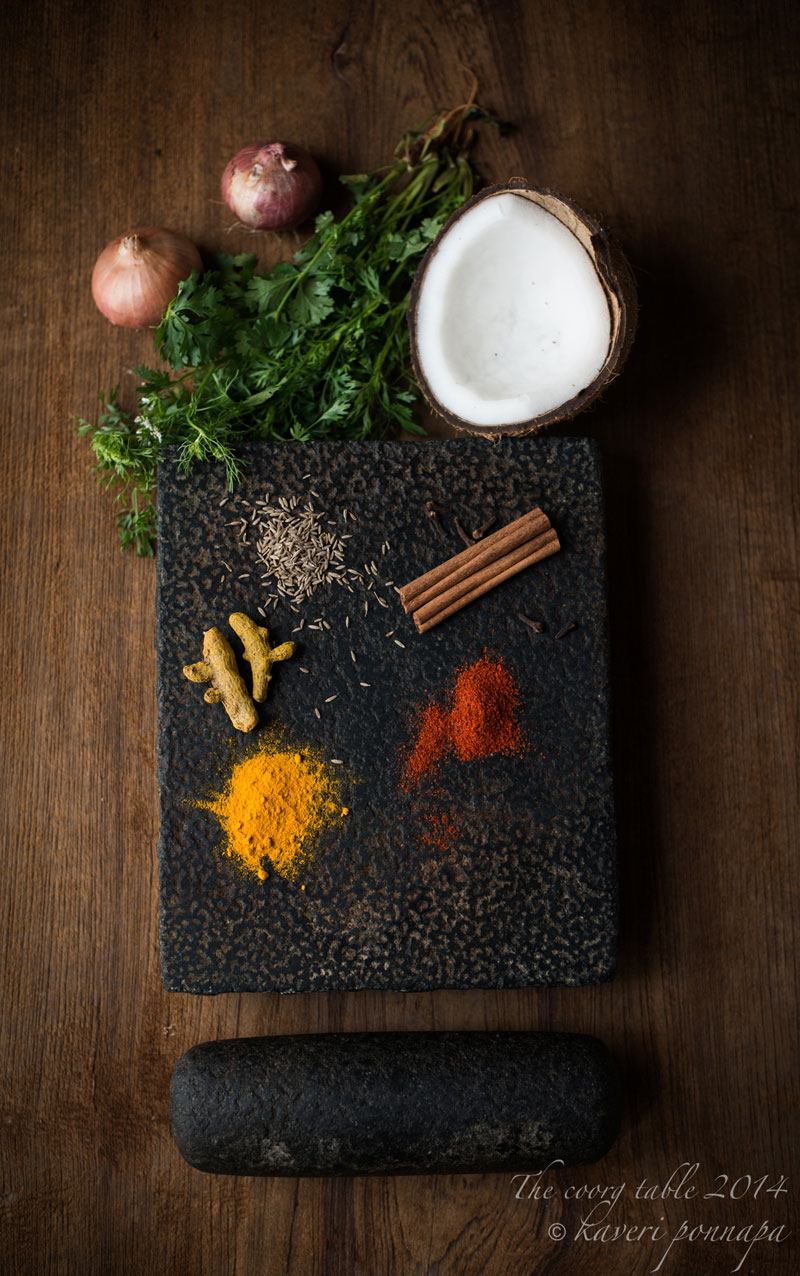
This interest in what goes onto other peoples’ tables is both casual and intense. The aftermath of a phone call is often a flurry of activity to prepare a similar dish to the one just discussed, or a plan for something like it the next day. Just how much food is discussed is something I took for granted: at weddings; over garden walls; on street corners; in formal drawing rooms and on telephones, conversations about food floated in the air everywhere, snippets lingering in your memory years, even decades later. As a teenager, I spent a lot of time at my grandparents’ home, watching my Grandmother and the oldest of my aunts’ cook. My aunt would sometimes disappear for what seemed like hours from the kitchen. Curious, I would wander after her, only to find her deep in conversation on the telephone with a friend or neighbour about some recipe, our afternoon meal temporarily forgotten.
My mother-in-law and her generation were certainly the original food bloggers. She had a gaggle of nieces who lived nearby and since she was a superb cook, hardly a day went by without one or the other of them calling to ask about a recipe for a much loved dish. She was so passionate about food, she would share and discuss recipes and cooking techniques over a fickle telephone connection that crackled fiercely, often by the light of an oil lamp, as the electricity supply frequently failed, prompting my father-in-law to ask in exasperation, why she hadn’t done all this when everyone had met just a few days before! I was grateful though, as I learnt a great deal, thanks to her interest in food.
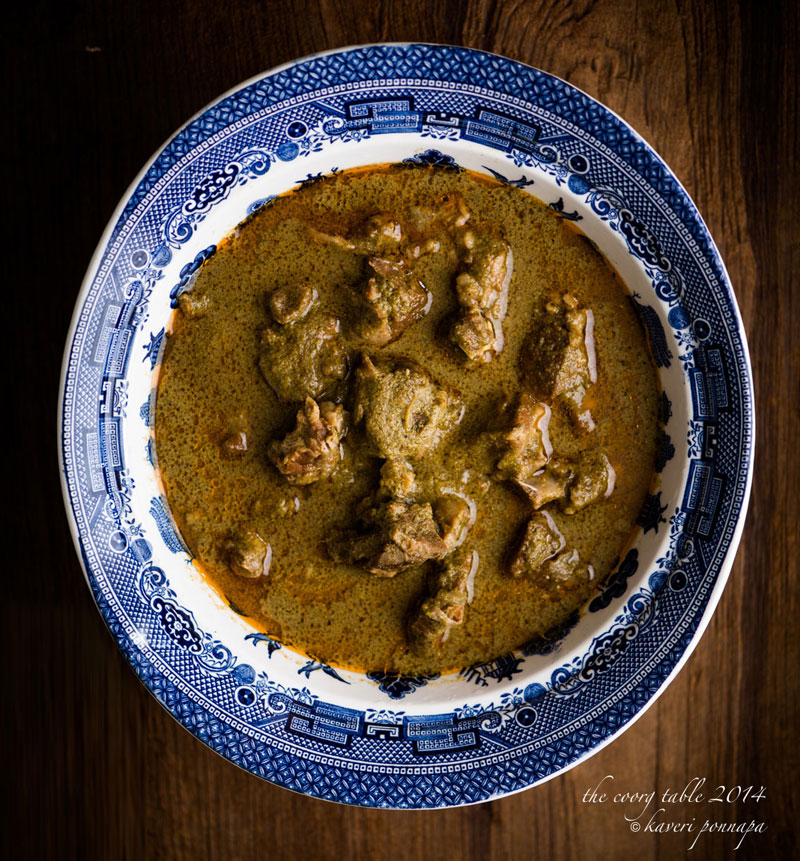
It always amazed me how she produced the most extraordinary meals from the tiniest of kitchens. The menu for the day always involved an element of surprise, as sometimes, unexpected ingredients arrived in the kitchen. But generally, there was always that one good dish, chosen from a repertoire of many dozens, which was the focus of a meal. It took so little to create a meal that was memorable. On days when we ate paputtu and erachi curry, there was not much to distract us from the main cast of flavours: “don’t put too much on the table at one time” was my mother-in-law’s advice. Erachi curry has tender cubes of mutton and some bone, in gravy tinged with the fresh green of coriander leaves ground with coconut that makes its rich base. A few whole spices, a few powdered ones, a touch of kachampuli, and you have one of the simplest, most pleasing curries ever. If you have the time and patience, it is worth every bit of the effort to grind the spice paste by hand, on a granite stone slab with a roller, arpe kall in Coorg. The masala you get adds its weight in gold in flavour to the curry. It is often eaten with paputtu, which gets its name from the milk in which it is cooked, soft, lightly sweetened, the perfect partner for the deep flavours of the curry.
Mutton and goat were, at one time, relatively difficult to come by in Coorg, bought from market towns. The meat usually came wrapped up in soggy newspaper, very fresh. It always arrived rather late in the morning, as it required a journey to the nearest market to buy it. But before long, aromas drifting all over the house would tell you that lunch was on its way and soon, the sharp sound of trays of paputtu being slammed onto the kitchen counter to turn it out could be heard. Once we were seated around my mother-in-law’s table, the scene was not too different from the one I described a little while ago – everyone engrossed in the food, making their own mental notes, ready to share them when the meal was done – which completes the circle for me, as I have her to thank for this curry and puttu. I take her advice on this one, and never put too much on the table with it – erachi curry definitely deserves your undivided attention.
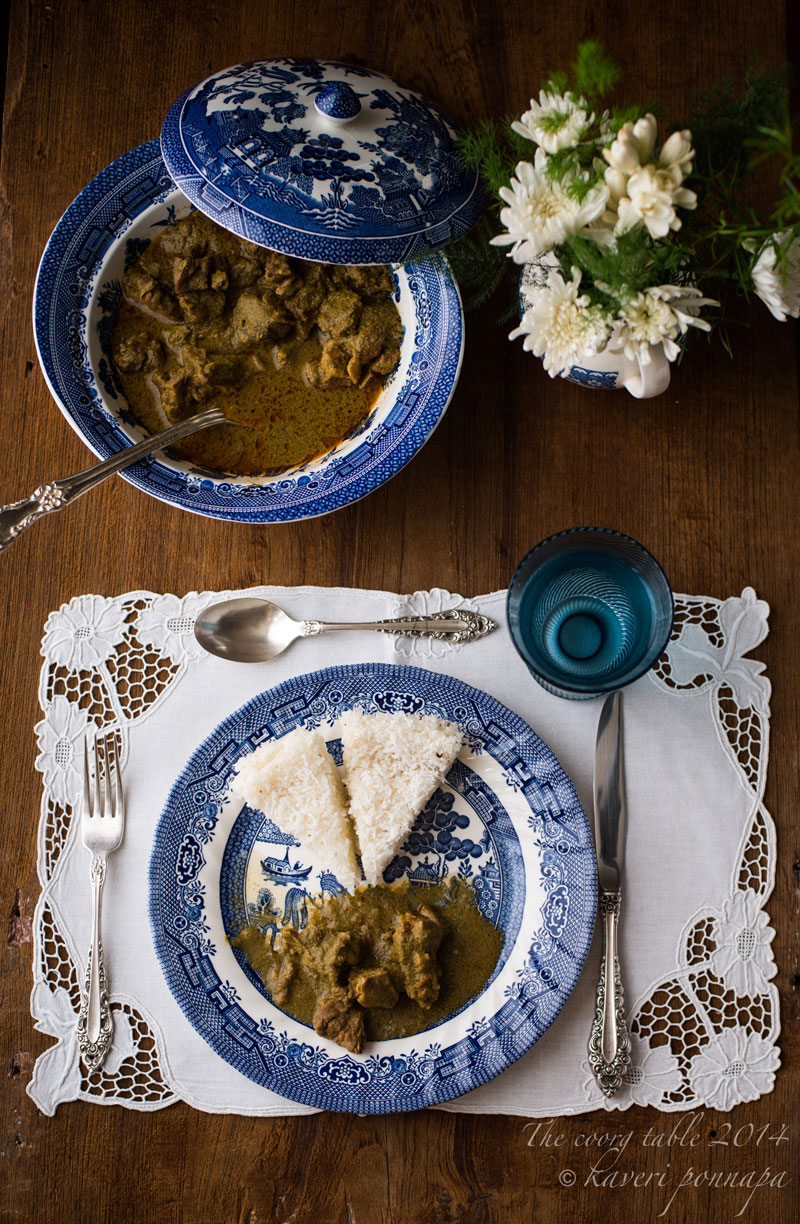
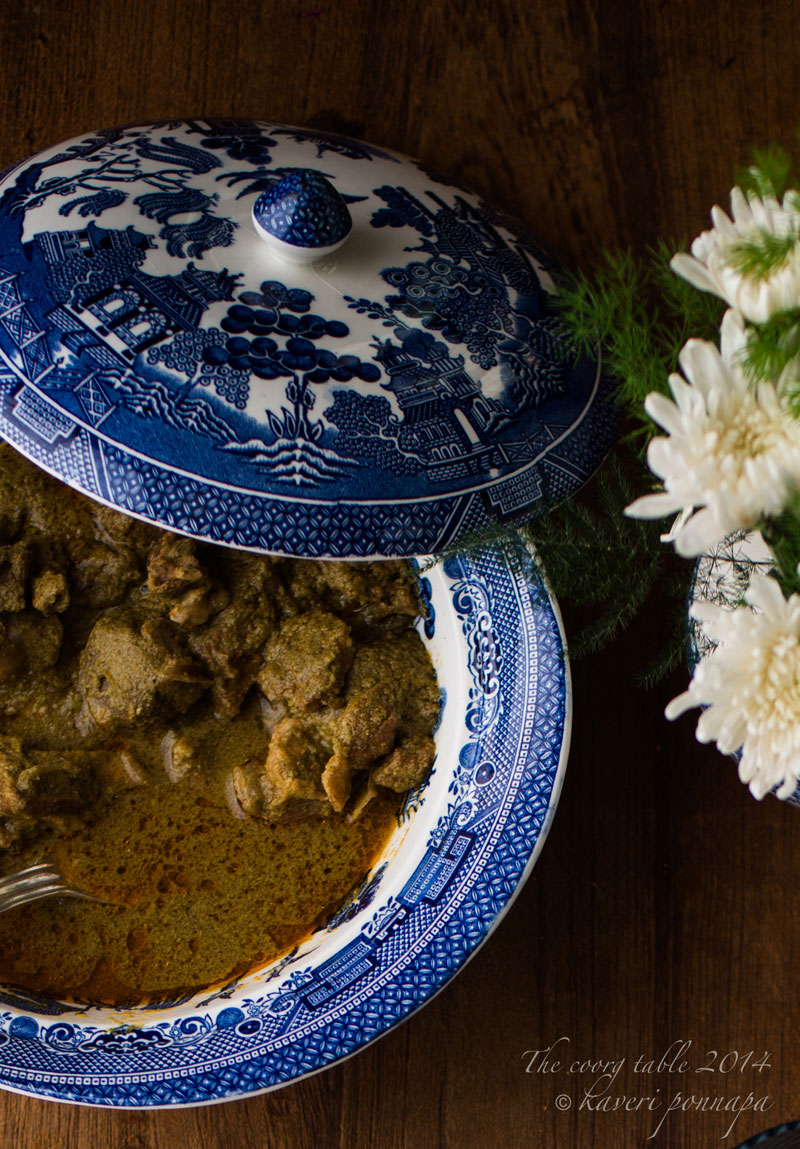
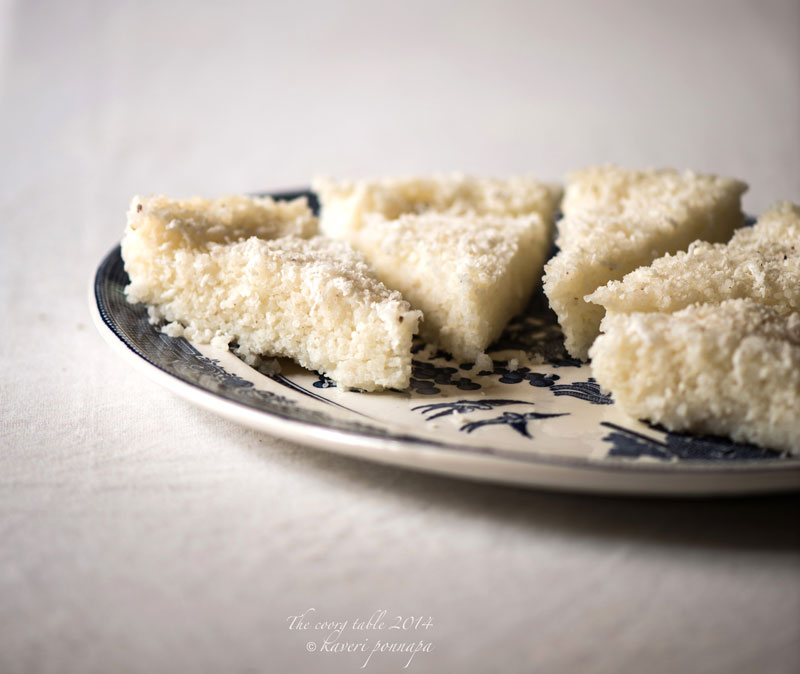
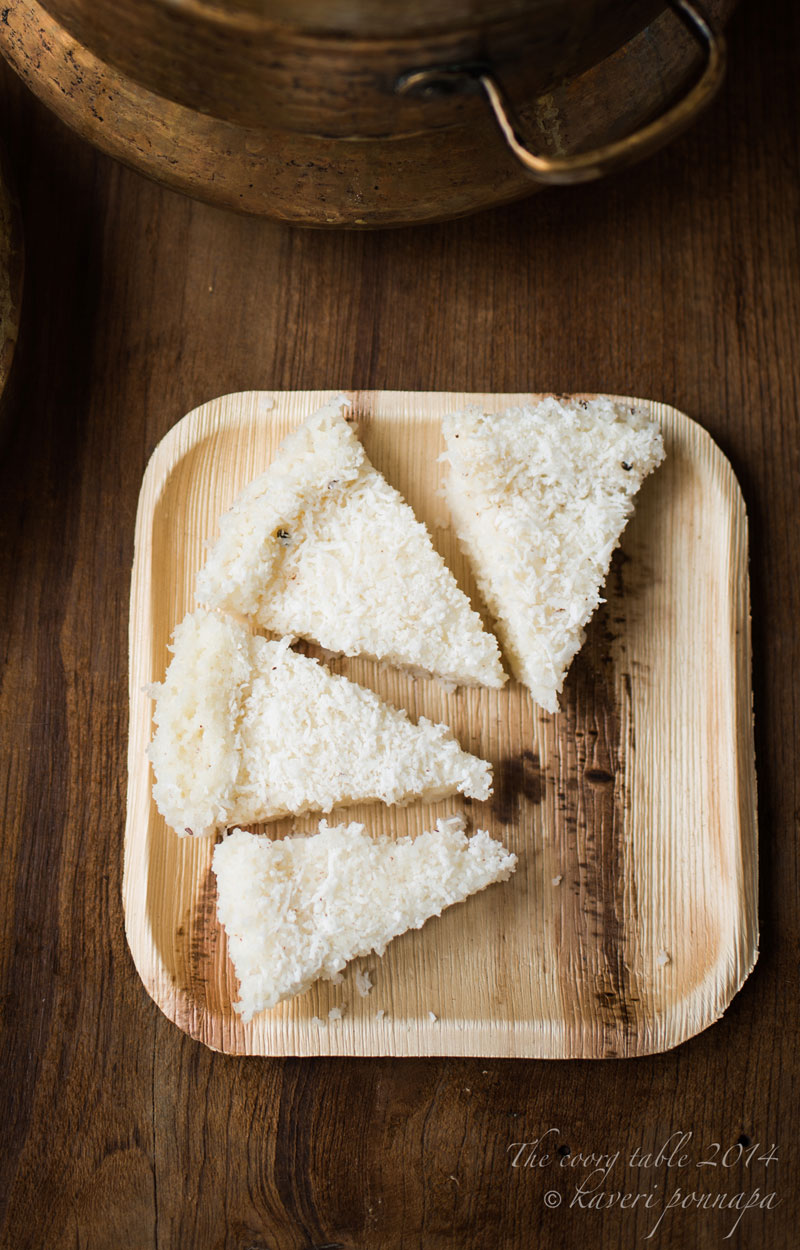
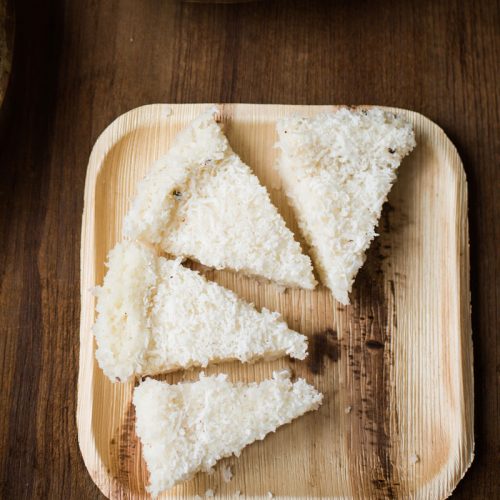
Paputtu - Cardamom flavoured steamed rice cakes
Equipment
- 1 Steamer or Pressure Cooker
Ingredients
- 1 Cup Paputtu tari (broken rice)
- 1 Cup Full fat milk
- 1 Cup Water
- ¼ tsp Salt
- 1 tbsp Sugar
- ½ Cup Freshly grated coconut
- 1 Pod Green Cardamom ,very lightly crushed
Instructions
- Give the tari a quick rinse, and soak in water, milk and the grated coconut for ½ an hour.
- Add the salt, sugar and cardamom, mix well. Gently squeeze the coconut in the liquid by hand, until it releases milk, and the mixture becomes creamy.
- Prepare a steamer or any vessel wide enough to hold an 8 ½ inch diameter plate, and bring the water to a boil. You can also cook the puttu in a pressure cooker without the weight, in case you don’t have a steamer. Place a slightly elevated stand over the boiling water.
- Pour the mixture into a shallow enamel plate approximately 8 ½ inch diameter, ½ inch in depth to fill less than ¾ of the plate. The puttu will expand, like rice, when cooked.
- Place plate with mixture on the stand in the steamer, close the lid and cook over medium-high heat for about 20 minutes until the paputtu is done.
- To turn out, lift out the plate, allow it to cool a little, then place your palm on the base, and slam down firmly onto a damp muslin cloth spread on the kitchen counter. Don’t be in a hurry to turn out the paputtu, as it will break if it is too hot. It may be best to allow the plate to cool completely the first few times, until you get a feel for turning out the puttu.
- Cut into 8 wedge shaped slices. Paputtus should be firm to the touch, soft but not mushy, and a delicate scent of cardamom should rise from them.
Thank you for visiting this page. If you read something that you enjoy, or see an image that you like, please take a moment to write a response. Do look out for the recipes of all the food featured here in my upcoming cookbook.
Image Credits: Nithin Sagi
All Food Styling: Kaveri Ponnapa

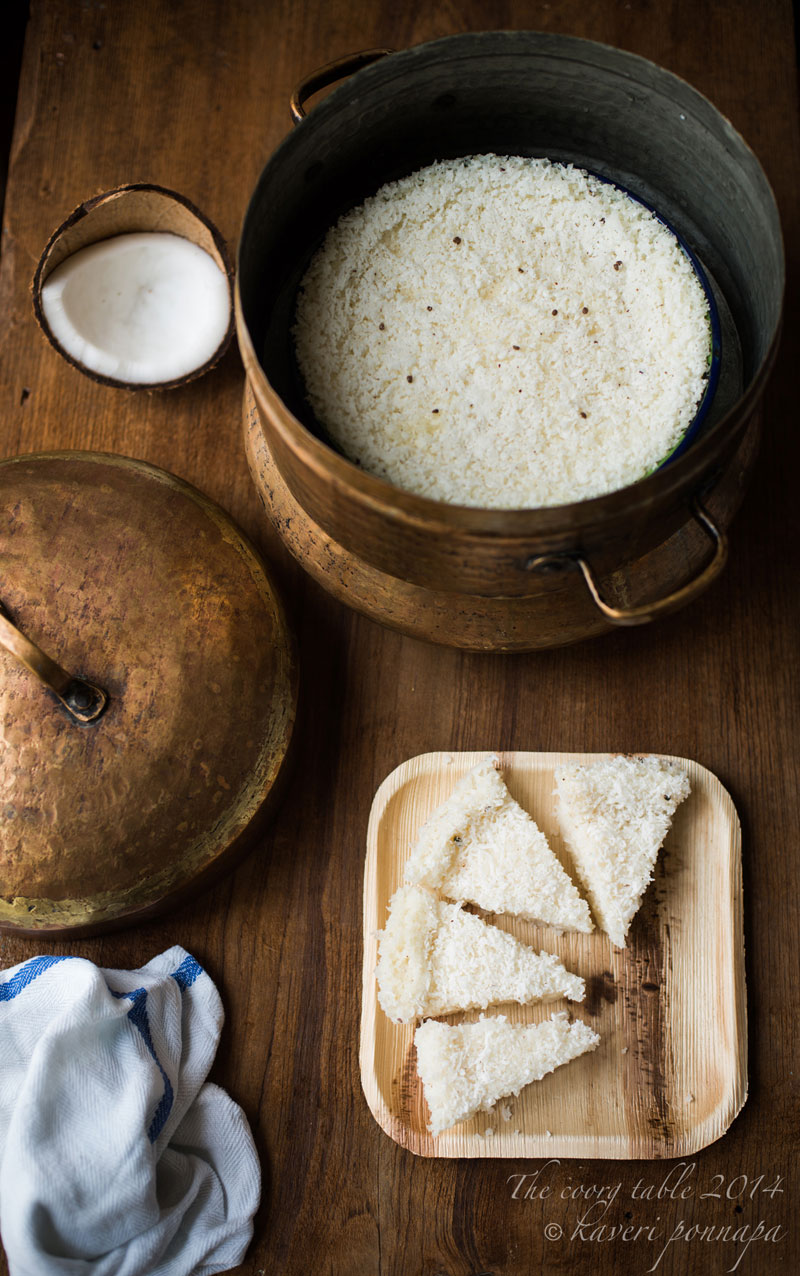

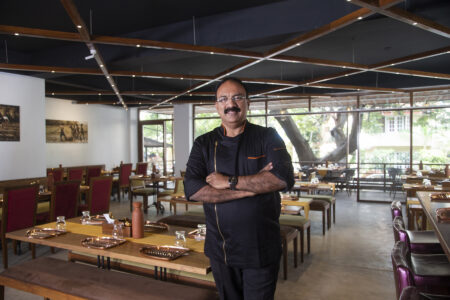
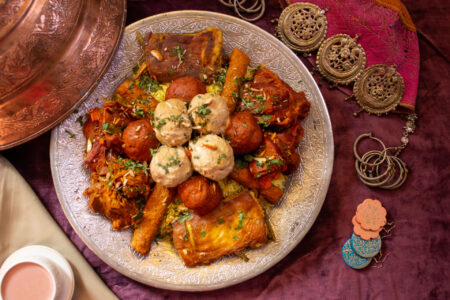
Please share the recipe of Paputtu and erachi curry please. I cannot find it any more in your site now
Hi Kaveri,
Thanks for the lovely photos and clear instructions. The paputtu is something I am going to try out as till now i have had north Kerala puttu and the Goanese sannas. My husband is from Kerala and a keen cook.
Thanks
mona
Hello Mona, thank you for visiting The Coorg Table. I’m sure that you will enjoy paputtu, it’s so easy to make, creamy and delicious, and goes with just about everything. Try eating it with butter and honey, or homemade jam! It’s great with chicken curry too. Do let me know how it turns out. Warm wishes. Kaveri
Greetings from Australia! A sudden desire to eat an old favourite led me most unexpectedly to your wonderful site… Initially it was our common first name that made me select your page… But since, I have spent several glorious minutes taking in the wonderful images and wondered excitedly at our shared sense of aesthetics! The ingredients for the paputtu lie forgotten on the benchtop in my kitchen and my husband is keen to rush over to the shops to get some meat to dish up one of your tempting curries!
Thank you so much for this wonderful blog – one that I will return to again and again! Also, keen to purchase The Vanishing Kodavas – I’ve checked out the details.
Hello Kaveri Rutherford, welcome to The Coorg Table. Thank you for all your generous words about these pages. I hope your paputtu was made after all, and that you and your husband enjoyed it. Do keep reading, and I hope that there will always be a post to interest you. It would be lovely to hear from you about the dishes you tried, and how they turned out. All good wishes. Kaveri
What wonderful memories you have 🙂 And that looks like such a beautiful Mutton curry. I am going to sure try this.
Hello Bhavna, yes, I am really fortunate to have some wonderful memories of food cooked and eaten in Coorg, both during my childhood and much later, after I was married. Life was changing all the while,although we did not realize it, and suddenly drawing on these memories became the only way back into a world that has almost disappeared. Do try the curry, it is simply delicious, and I would love to hear from you again. Warm wishes.Kaveri
Dear Mam NAMASTE!!!!!!!
As per your recipe i tried this Paputtu and Iraichi curry it was Excellent!!!!! Thank you so much for your delicious recipe share with us …
Chef N.Nanda Kumar
Hello, Chef! I am so glad the food turned out excellent. It’s a pleasure to share authentic Coorg recipes for people to enjoy.There are also several very good vegetarian dishes that you can try out.Thank you for getting in touch, and I hope you will continue to follow The Coorg Table. Best wishes, Kaveri.
I have heard that Paputtu and erachi curry is a great combination, My cousins love to have paputtu with erachi and koli curry they enjoy eating. But for me, I love to eat Paputtu with honey or egg curry….even it makes a great combination…..WoW Lovely images nice to see Paputtu… Thank you!!!
Paputtu is wonderful with so many different curries and in so many different combinations. And you are right, it’s absolutely delicious with honey, and I have to add, homemade butter! Sweet paputtu, made with a little extra sugar is good enough to eat by itself. I’m glad you like the images! Warm wishes, Kaveri
I discovered that the Coorg restaurant near my home sold something called paputtu, we ordered it and it was really lovely to eat with the pork gravy. A few days later daughter wanted me to try it out so i searched and found your recipe. I tried it and the paputtu came out really well! I’m making it again today so I thought I’d let you know how we enjoyed making this Coorgi delicacy in our home. We’ll be having it with some chicken gravy. I’ll try your mutton curry one of these days. Thanks for your lovely writing and memories as well as the great recipes.
Hello Cynthia, thank you for writing— glad to hear you tried making paputtu, and that you enjoyed it. It works very well with both chicken and mutton curry, and it’s one of the easiest puttus to make. Do try it at breakfast with honey and butter, it’s delicious. Kaveri.